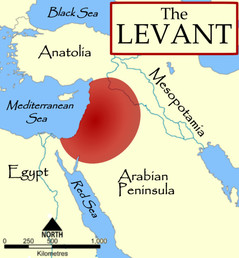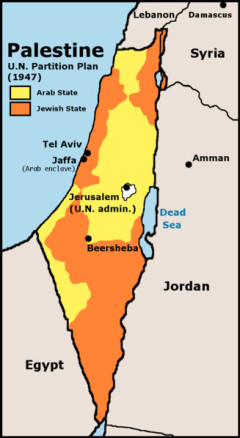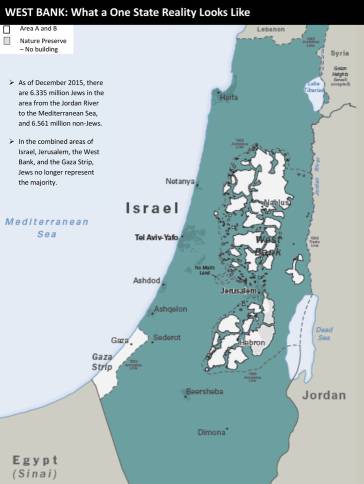= = HISTORY OF PALESTINE = =
Once upon a time ....
Many civilisations have ruled this land, the area is roughly known as the 'The Levant' and below you can see a table charting the different civilisations which lived here, prior to the Muslim and Jewish civilisations.
This information below tells us that yes Jews had lived in The Levant for hundreds of years, but as Nomadic Tribes, with no actual Homeland or Nation. During the Hebrew Bible period (1020BCE - 720 BCE) they were ruled largely by the Romans. The Hasmonean Dynasty (140 BCE - 63 BCE) was what one would term as acutal Jewish Rule, thus only around 77 years of Jewish rule.
Now if you look at Muslim rule it was from 630 CE to 1917 CE, minus the Christian Crusader rule (1099 CE - 1187 CE) thus around 1,200 years of Muslim rule.
This in terms of Historical rights and such, the Muslims had been ruling the Hold Land for a much longer period of time, and thus had a vastly more superior claim to that land.
Paleolithic and Neolithic periods (1 mya–5000 BCE)
Palestine is an area which has been inhabited for a very long time, in fact the earliest human remains were found in Ubeidiya, some 3 km south of the Sea of Galilee (Lake Tiberias), in the Jordan Rift Valley; these remains are dated to the Pleistocene, ca. 1.5 million years ago.
Between 10000 and 5000 BCE, agricultural communities were established. Evidence of such settlements were found at Tel es-Sultan in Jericho and consisted of a number of walls, a religious shrine, and a 23-foot (7.0 m) tower with an internal staircase. Jericho is believed to be one of the oldest continuously inhabited cities in the world, with evidence of settlement dating back to 9000 BC.
The Levant is a geographical term that refers to a large area in Southwest Asia, south of the Taurus Mountains, bounded by the Mediterranean Sea in the west, the Arabian Desert in the south, and the Zagros Mountains in the east. The term is also sometimes used to refer to modern events or states in the region immediately bordering the eastern Mediterranean Sea: Israel, Palestinian territories, Jordan, Lebanon, and Syria.
Chalcolithic period (4500–3000 BCE) and Bronze Age (3000–1200 BCE)
By the early Bronze Age (3000–2200 BCE) independent Canaanite city-states situated in plains and coastal regions and surrounded by mud-brick defensive walls were established and most of these cities relied on nearby agricultural hamlets for their food needs.
Archaeological finds from the early Canaanite era have been found at Tel Megiddo, Jericho, Tel al-Far'a (Gaza), Bisan, and Ai (Deir Dibwan/Ramallah District), Tel an Nasbe (al-Bireh) and Jib (Jerusalem).
The Canaanite city-states held trade and diplomatic relations with Egypt and Syria. Parts of the Canaanite urban civilization were destroyed around 2300 BCE, though there is no consensus as to why. Incursions by nomads from the east of the Jordan River who settled in the hills followed soon thereafter.
In the Middle Bronze Age (2200–1500 BCE), Canaan was influenced by the surrounding civilizations of Egypt, Mesopotamia, Phoenicia, and Syria. Diverse commercial ties and an agriculturally based economy led to the development of new pottery forms, the cultivation of grapes, and the extensive use of bronze.Burial customs from this time seemed to be influenced by a belief in the afterlife.
Political, commercial and military events during the Late Bronze Age period (1450–1350 BCE) were recorded by ambassadors and Canaanite proxy rulers for Egypt in 379 cuneiform tablets known as the Amarna Letters.
By c. 1190 BCE, the Philistines arrived and mingled with the local population, losing their separate identity over several generations.
Iron Age (1200–330 BCE)
Pottery remains found in Ashkelon (Al Majdal-Palestine) Ashdod, Gath (city), Ekron and Gaza decorated with stylized birds provided the first archaeological evidence for Philistine settlement in the region. The Philistines are credited with introducing iron weapons and chariots to the local population. Excavations have established that the late 13th, the 12th and the early 11th centuries BCE witnessed the foundation of perhaps hundreds of insignificant, unprotected village settlements, many in the mountains of Palestine. From around the 11th century BCE, there was a reduction in the number of villages, though this was counterbalanced by the rise of certain settlements to the status of fortified townships.
Developments in Palestine between 1250 and 900 BCE have been the focus of debate between those who accept the Old Testament version on the conquest of Canaan by the Israelite tribes, and those who reject it. Niels Peter Lemche, of the Copenhagen School of Biblical Studies, submits that the picture of ancient Israel "is contrary to any image of ancient Palestinian society that can be established on the basis of ancient sources from Palestine or referring to Palestine and that there is no way this image in the Bible can be reconciled with the historical past of the region."
Sites and artifacts, including the Large Stone Structure, Mount Ebal, the Menertaph, and Mesha stelae, among others, are subject to widely varying historical interpretations: the "conservative camp" reconstructs the history of Israel according to the biblical text and views archaeological evidence in that context, whilst scholars in the minimalist or deconstructionist school hold that there is no archaeological evidence supporting the idea of a United Monarchy (or Israelite nation) and the biblical account is a religious mythology created by Judean scribes in the Persian and Hellenistic periods; a third camp of centrist scholars acknowledges the value of some isolated elements of the Pentateuch and of Deuteronomonistic accounts as potentially valid history of monarchic times that can be in accord with the archaeological evidence, but argue that nevertheless the biblical narrative should be understood as highly ideological and adapted to the needs of the community at the time of its compilation.
Additional extrabiblical references
An archaeological textual reference concerning the territory of Palestine is thought to have been made in the Merneptah Stele, dated c. 1200 BCE, containing a recount of Egyptian king Merneptah's victories in the land of Canaan, mentioning place-names such as Gezer, Ashkelon and Yanoam, along with Israel, which is mentioned using a hieroglyphic determinative that indicates a nomad people, rather than a state.
This PROVES that 'israel' was not a NATION but they were referred to as just 'Foreign Poeple' and just 'Nomads' .. this is the TRUTH which for centuries the israelis have been trying to hide in order to build a claim to take voer Palestine and create 'israel' .. 'israel' never existed as a nation, so they have no right at all to take over Palestine, no right at all.
This title "Israel Stele" is somewhat misleading because the stele only makes a brief mention of Israel and Canaan. The next ascertained mention of "Israel" dates to the 9th century, found on the Mesha Stele.
The line mentioning Israel is grouped together with three other defeated states in Canaan (Gezer, Yanoam and Ashkelon) in a single stanza, beside multiple stanzas regarding his defeat of the Libyans. The line referring to Merneptah's Canaanite campaign reads:
Canaan is captive with all woe. Ashkelon is conquered, Gezer seized, Yanoam made nonexistent; Israel is wasted, bare of seed.[6]
The phrase "wasted, bare of seed" is formulaic, and often used of defeated nations. It implies that the store of grain of the nation in question has been destroyed, which would result in a famine the following year, incapacitating them as a military threat to Egypt.
|
|
|
|
|
|||||||||||||||||||
|
|
|
|
|
|
|||||||||||||||||||
| ysrỉr[8] | fk.t | bn | pr.t | =f | |||||||||||||||||||
| Israel | waste | [negative] | seed/grain | his/its |
The stela does make clear that "Israel" at this stage, refers to a people since the hieroglyphic determinative for "country" is absent for Israel.
While the other defeated Egyptian enemies listed besides Israel in this document such as Ashkelon, Gezer and Yanoam were given the determinative for a city-state—"a throw stick plus three mountains designating a foreign country"—the hieroglyphs that refer to Israel instead employ the determinative sign used for foreign peoples: a throw stick plus a man and a woman over three vertical plural lines. This sign is typically used by the Egyptians to signify nomadic tribes without a fixed city-state, thus implying that ysrỉr "Israel" was the demonym for a seminomadic or rural population at the time the stele was created.[9]
Another famous inscription is that of the Mesha Stele, bearing an inscription by the 9th century BC Moabite King Mesha, discovered in 1868 at Dhiban (biblical "Dibon," capital of Moab) now in Jordan. The Stele is notable because it is thought to be the earliest known reference to the sacred Hebrew name of God – YHWH. It also notable as the most extensive inscription ever recovered that refers to ancient Israel. Again it indicates a nomad people, rather than a state or nation.
This information tells us that Yes Jews had lived in The Levant for hudnreds of years, but as Nomadic Tribes, with no actual Homeland or Nation. During the Hebrew Bible period (1020BCE - 720 BCE) they were ruled largely by the Romans. The Hasmonean Dynasty (140 BCE - 63 BCE) was what one would term as acutal Jewish Rule, thus only around 77 years of Jewish rule.
Now if you look at Muslim rule it was from 630 CE to 1917 CE, minus the Christian Crusader rule (1099 CE - 1187 CE) thus around 1,200 years of Muslim rule.
This in terms of Historical rights and such, the Muslims had been ruling the Hold Land for a much longer period of time, and thus had a vastly more superior claim to that land.
Hebrew Bible period (1020 BCE - 720 BCE) JEWISH
Assyrian Empire (720 BCE - 538 BCE) ASSYRIAN
Persian rule (538 BCE - 333
BCE) PERSIAN
Hellenistic rule (333 BCE - 140BCE)
GREEK
Hasmonean dynasty (140 BCE - 63 BCE) JEWISH
Roman rule (63 BCE - 330
CE)
ROMAN
Byzantine (Eastern Roman Empire) (330-640 CE) ROMAN
Islamic period (630-1918
CE)
ISLAMIC
Arab Caliphate rule (638-1099 CE) ISLAMIC
Umayyad rule (661-750
CE)
ISLAMIC
Abbasid rule (750-969
CE)
ISLAMIC
Crusader rule (1099-1187
CE)
CHRISTIAN
Mamluk rule (1270-1516
CE)
ISLAMIC
Ottoman rule (1516-1831
CE)
ISLAMIC
Egyptian rule
(1831-1841)
ISLAMIC
Ottoman rule
(1841-1917)
ISLAMIC
GUARDIAN NEWSPAPER - Israeli-Arab Conflict Map
CLICK HERE to view an Interactive History of the Arab-Israeli Conflict.
http://www.guardian.co.uk/flash/0,,720353,00.html
British Mandate (1920–1948)
Following World War 1, the Ottoman Empire was carved up by the Allied Supreme Council (America, Britain, France, Italy) and Britain took control of Palestine, then the Mandate was approved by the League of Nations on 24th July 1922. This period was very turbulent as on 16th September 1922 Lord Balfour had his infamous Memorandom approved by the League of Nations which concerned the creation of a Jewish national home and the facilitation of Jewish immigration and lane settlement. This obvious led to a lot of tensions, immigration is always a hotly debated topic even in this day and age, so you can imagine how the Palestinians felt about having a mass influx of immigrants and being forced to hand over their land to them. This period was marred by Revolts and unrest.
UN partition and the 1948 Palestine War
On 29 November 1947, the United Nations General Assembly voted 33 to 13 with 10 abstentions, in favour of a plan to partition the territory into separate Jewish and Arab states, under economic union, with the Greater Jerusalem area (encompassing Bethlehem) coming under international control. Zionist leaders (including the Jewish Agency), accepted the plan, while all Palestinian Arab leaders rejected it and all independent Muslim and Arab states voted against it. Yet dispite all these objection the plan was implemented and almost immediately, sectarian violence erupted and spread, killing over the ensuing months hundreds of Arabs, Jews and British.
The rapid evolution of events precipitated into a Civil War. Arab volunteers of the Arab Liberation Army entered Palestine to fight with the Palestinians, but the April-May offensive of Yishuv's forces crushed the Arabs and Palestinian society collapsed. Some 300,000 to 350,000 Palestinians caught up in the turmoil fled or were driven from their homes.
On 14 May 1948, the Jewish Agency declared the independence of the state of Israel. The neighbouring Arab state intervened to prevent the partition and support the Palestinian Arab population. While Transjordan took control of territory designated for the future Arab State, Syrian, Iraqi and Egyptian expeditionary forces attacked Israel without success. The most intensive battles were waged between the Jordanian and Israeli forces over the control of Jerusalem.
On June 11 1948, a truce was accepted by all parties. Israel used the lull to undertake a large-scale reinforcement of its army. In a series of military operations, it then conquered the whole of the Galilee region, both the Lydda and Ramle areas, and the Negev. It also managed to secure, in the Battles of Latrun, a road linking Jerusalem to Israel. In this phase, 350,000 more Arab Palestinians fled or were expelled from the conquered areas.
During the first 6 months of 1949, negotiations between the belligerents came to terms over armistice lines that delimited Israel's borders. On the other side, no Palestinian Arab state was founded: Jordan annexed the Arab territories of the Mandatory regions of Samaria and Judea (today known as the West Bank), as well as East Jerusalem, while the Gaza strip came under Egyptian administration.
The New Historians, like Avi Shlaim, hold that there was an unwritten secret agreement between King Abdullah of Transjordan and Israeli authorities to partition the territory between themselves, and that this translated into each side limiting their objectives and exercising mutual restraint during the 1948 war.
On the same day that the State of Israel was announced, the Arab League announced that it would set up a single Arab civil administration throughout Palestine. The All-Palestine government was declared in Gaza on 1 October 1948, partly as an Arab League move to limit the influence of Transjordan over the Palestinian issue. The former mufti of Jerusalem, Haj Amin al-Husseini, was appointed as president. The government was recognised by Egypt, Syria, Lebanon, Iraq, Saudi Arabia, and Yemen, but not by Transjordan (later known as Jordan) or any non-Arab country. It was little more than an Egyptian protectorate and had negligible influence or funding.
Following the 1948 Arab-Israeli War, the area allocated to the Palestinian Arabs and the international zone of Jerusalem were occupied by Israel and the neighboring Arab states in accordance with the terms of the 1949 Armistice Agreements.
In addition to the UN-partitioned area allotted to the Jewish state, Israel captured and incorporated a further 26% of the Mandate territory (namely of the territory to the west of the Jordan river). Jordan captured and annexed about 21% of the Mandate territory, which it referred to as the West Bank (to differentiate it from the newly-named East Bank - the original Transjordan). Jerusalem was divided, with Jordan taking the eastern parts, including the Old City, and Israel taking the western parts. The Gaza Strip was captured by Egypt. In addition, Syria held on to small slivers of Mandate territory to the south and east of the Sea of Galilee, which had been allocated in the UN partition plan to the Jewish state.
In a nutshell on 29th November 1947 the UN decided to split Palestine and create a Jewish state. Every neighbouring state rejected the plan yet the UN pushed ahead with it despite the many objections. Then a Civil War ensured and on 14th May 1948 Israel declared indpendence, this caused resulted in the Arab-Israeli War of 1948. On 11th June 1948 a truce was signed, it appears to many that Tranjordan (Jordan) did a secret deal with Israel. It was bad enough Palestine lost a lot of land to the Jewish state, but by 1948 they had lost a further 26% of land to the Jewish state and a further 21% to Jordan.
The Six-Day War - 5th to 10th June 1967
The Six-Day War of June 5-10, 1967 was a war between the Israeli army and the armies of the neighboring states of Egypt, Jordan, and Syria. The Arab states of Iraq, Saudi Arabia, Sudan, Tunisia, Morocco and Algeria also contributed troops and arms.
In Arabic, the war is called (Arabic: حرب الأيام الستة, Ḥarb al‑Ayyam as‑Sitta or more commonly Arabic: حرب 1967, Ḥarb 1967. In Hebrew: מלחמת ששת הימים, Milhemet Sheshet Ha‑Yamim). It is also known as the 1967 Arab-Israeli War, the Third Arab-Israeli War, Six Days' War, an‑Naksah (The Setback), or the June War.
Following numerous border clashes between Israel and its Arab neighbours, particularly Syria, Egyptian President Gamal Abdel Nasser expelled the United Nations Emergency Force (UNEF) from the Sinai Peninsula in May 1967. The peacekeeping force had been stationed there since 1957, following a British-French-Israeli invasion of Egypt which was launched during the Suez Crisis. Egypt amassed 1,000 tanks and nearly 100,000 soldiers on the Israeli border and closed the Straits of Tiran to all ships flying Israeli flags or carrying strategic materials, receiving strong support from other Arab countries. Israel responded with a similar mobilization that included the call up of 70,000 reservists to augment the regular IDF forces.
On June 5, 1967, Israel launched a surprise attack on Egypt and Syria. Israel has always considered this a preemptive attack. This is, however, disputed by Arab countries, who assert that Israel's strike was an unwarranted and illegal act of aggression. Jordan, which had signed a mutual defence treaty with Egypt on May 30, then attacked western Jerusalem and Netanya.
At the war's end, Israel had gained control of the Sinai Peninsula, the Gaza Strip, the West Bank, East Jerusalem, and the Golan Heights. The results of the war affect the geopolitics of the region to this day.
So as well as losing land in 1947 when the UN decided to create a Jewish state, and as well as losing further land in the 1948 Arab-Israeli War (26% to Israel and 21% to Jordan), the Palestians lost yet more land and the control of Jerusalem in 1967. The situation has only become worse as the remaining territory has been riddled with illegal Israeli settlements and checkpoints on occupied territory.





![M17 [i] i](http://en.wikipedia.org/w/extensions/wikihiero/img/hiero_M17.png)
![O34 [z] z](http://en.wikipedia.org/w/extensions/wikihiero/img/hiero_O34.png)

![D21 [r] r](http://en.wikipedia.org/w/extensions/wikihiero/img/hiero_D21.png)
![G1 [A] A](http://en.wikipedia.org/w/extensions/wikihiero/img/hiero_G1.png)





![I9 [f] f](http://en.wikipedia.org/w/extensions/wikihiero/img/hiero_I9.png)
![V31 [k] k](http://en.wikipedia.org/w/extensions/wikihiero/img/hiero_V31.png)
![X1 [t] t](http://en.wikipedia.org/w/extensions/wikihiero/img/hiero_X1.png)

![D58 [b] b](http://en.wikipedia.org/w/extensions/wikihiero/img/hiero_D58.png)
![N35 [n] n](http://en.wikipedia.org/w/extensions/wikihiero/img/hiero_N35.png)









